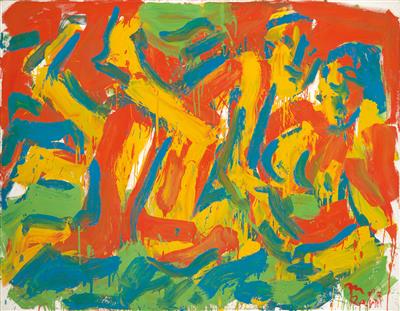Otto Muehl *

(Grodnau 1925–2013 Moncarapacho, Portugal)
Untitled, monogrammed and dated M 87, 28 VIII, oil on canvas, 140 x 180 cm, framed, (K)
Provenance:
From an Austrian Collection
Why is there Actionism in Austria? Actionist activities are indeed very intense.
They even move into the sphere of life. Romantic art, on the other hand, is totally formal. Cézanne is so formal that reality is extinguished. This is similarly the case with Picasso. Although he spoke of demolition, it is no shattering of reality, instead it is formal, the object sacrificed to the composition of the picture. While the Austrian is trite and unsophisticated, he does not want to abandon the object (laugh), he does not want to sacrifice it. I remember that when I was studying I discovered Schiele. His lines are like music. They are intoxicating. It is not so much about the bodies. The curves are intoxicating, and they are even better when they delineate a lovely female body. Klimt also had it, combined with eroticism. And I had no idea. When I started at the Academy I was effectively still making childish drawings from my imagination. After the war, no one even knew of van Gogh or Picasso, as under the Nazis all that art was considered degenerate. And when I first saw Schiele in 1950 or 1952 these lines immediately struck me. I wanted to trace them, but I could not. Professor Boekle said that what Schiele had made was just lines of straw – Boekle was a painter. He was a good painter, but more an Austrian local; he was no Egon Schiele. He was almost the same age as Schiele. And then I met a railwayman who knew Schiele and had bought pictures from him in 1915/16. I visited him. Out of a drawer he pulled drawings by Schiele. And I was totally amazed. I believe he bequeathed the drawings to the Albertina. I have forgotten his name. Later I rejected Schiele because I got to know Cézanne and van Gogh, and thought that Schiele was too naturalistic. I got so flustered over the eroticism, like a bourgeois person, thinking it perverse. Then I went the more formal route, I had to catch up, and only now am I returning via French painting, these mountains, back onto Austrian meadows and pastures (laugh) and am become a goat and cow herder.
Otto Muehl, Aus dem Gefängnis, 1991–1997, published by Ritter, 1997
Specialist: Mag. Elke Königseder
 Mag. Elke Königseder
Mag. Elke Königseder
+43-1-515 60-358
elke.koenigseder@dorotheum.at
27.11.2014 - 14:00
- Realized price: **
-
EUR 30,000.-
- Estimate:
-
EUR 28,000.- to EUR 38,000.-
Otto Muehl *
(Grodnau 1925–2013 Moncarapacho, Portugal)
Untitled, monogrammed and dated M 87, 28 VIII, oil on canvas, 140 x 180 cm, framed, (K)
Provenance:
From an Austrian Collection
Why is there Actionism in Austria? Actionist activities are indeed very intense.
They even move into the sphere of life. Romantic art, on the other hand, is totally formal. Cézanne is so formal that reality is extinguished. This is similarly the case with Picasso. Although he spoke of demolition, it is no shattering of reality, instead it is formal, the object sacrificed to the composition of the picture. While the Austrian is trite and unsophisticated, he does not want to abandon the object (laugh), he does not want to sacrifice it. I remember that when I was studying I discovered Schiele. His lines are like music. They are intoxicating. It is not so much about the bodies. The curves are intoxicating, and they are even better when they delineate a lovely female body. Klimt also had it, combined with eroticism. And I had no idea. When I started at the Academy I was effectively still making childish drawings from my imagination. After the war, no one even knew of van Gogh or Picasso, as under the Nazis all that art was considered degenerate. And when I first saw Schiele in 1950 or 1952 these lines immediately struck me. I wanted to trace them, but I could not. Professor Boekle said that what Schiele had made was just lines of straw – Boekle was a painter. He was a good painter, but more an Austrian local; he was no Egon Schiele. He was almost the same age as Schiele. And then I met a railwayman who knew Schiele and had bought pictures from him in 1915/16. I visited him. Out of a drawer he pulled drawings by Schiele. And I was totally amazed. I believe he bequeathed the drawings to the Albertina. I have forgotten his name. Later I rejected Schiele because I got to know Cézanne and van Gogh, and thought that Schiele was too naturalistic. I got so flustered over the eroticism, like a bourgeois person, thinking it perverse. Then I went the more formal route, I had to catch up, and only now am I returning via French painting, these mountains, back onto Austrian meadows and pastures (laugh) and am become a goat and cow herder.
Otto Muehl, Aus dem Gefängnis, 1991–1997, published by Ritter, 1997
Specialist: Mag. Elke Königseder
 Mag. Elke Königseder
Mag. Elke Königseder
+43-1-515 60-358
elke.koenigseder@dorotheum.at
|
Buyers hotline
Mon.-Fri.: 10.00am - 5.00pm
kundendienst@dorotheum.at +43 1 515 60 200 |
| Auction: | Contemporary Art - Part 2 |
| Auction type: | Saleroom auction |
| Date: | 27.11.2014 - 14:00 |
| Location: | Vienna | Palais Dorotheum |
| Exhibition: | 15.11. - 27.11.2014 |
** Purchase price incl. buyer's premium and VAT
It is not possible to turn in online buying orders anymore. The auction is in preparation or has been executed already.
